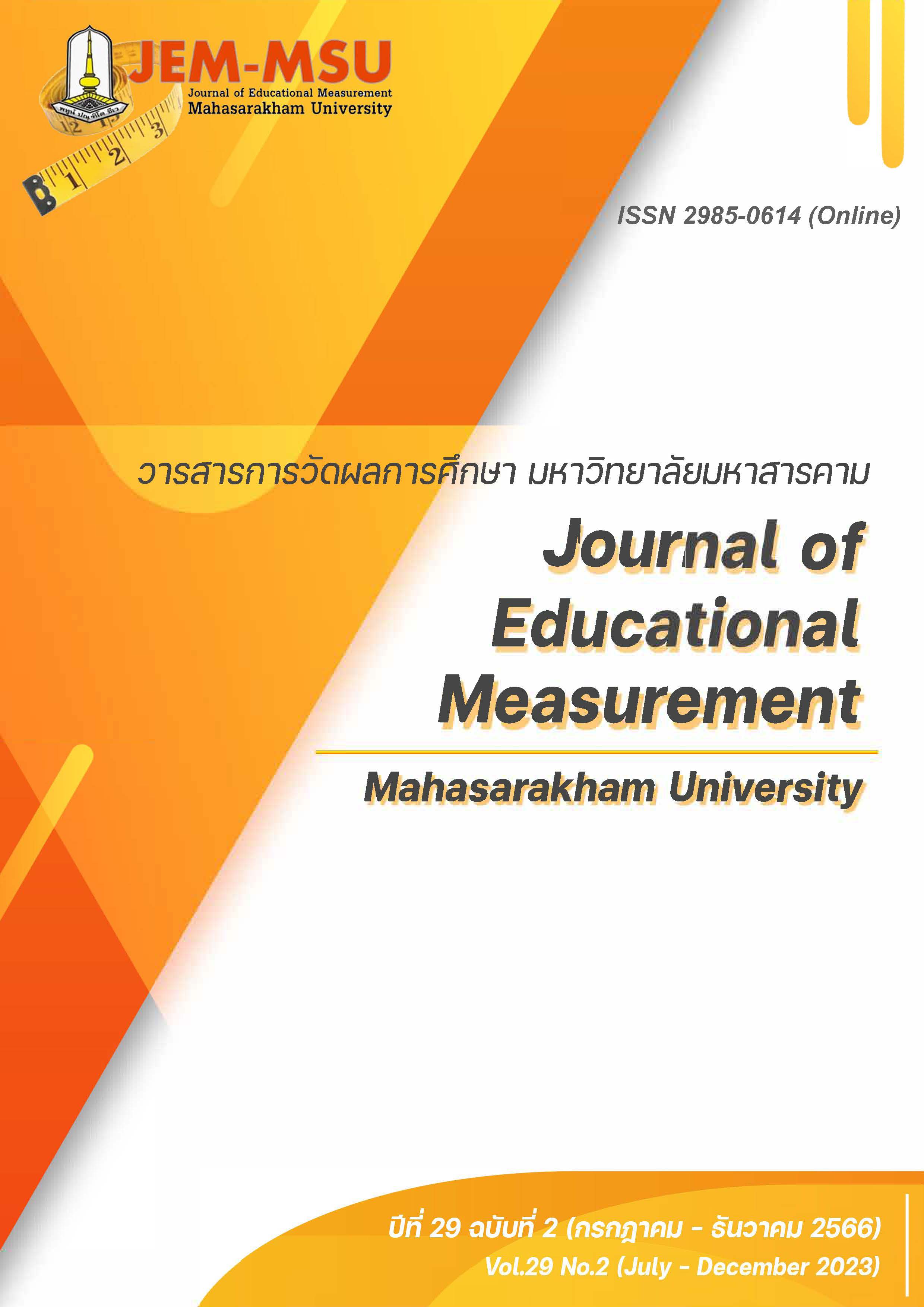Construction of Item Bank in Mathematics for Fourth Grade Students: An Application of One-Parameter Item Response Theory
Main Article Content
Abstract
The objectives of this research were to 1) study the needs of mathematics teachers for constructing an item bank in mathematics, on the topic of decimal, for fourth grade students, and 2) construct an item bank in mathematics, on the topic of decimal, for fourth grade students, classified according to the level of difficulty and level of cognitive domain.
The sample consisted of 18 mathematics teachers and 281 fourth grade students. The research tools were a questionnaire and mathematics tests on decimals for fourth grade students. Data were analyzed by using frequency, percentage, difficulty, item information function, test information function and reliability, using an application of one-parameter item response theory.
The research results were as follows:
1. Regarding the results of the study on needs of mathematics teachers for constructing an item bank in mathematics, on the topic of decimal, for fourth grade students, it was found that what the teachers needed most were 3 tests with 10-20 questions, both objective and subjective. Meanwhile, the cognitive learning behavior most needed was analysis.
2. Regarding the results of constructing the item bank in mathematics, on the topic of decimal, for fourth grade students, there were 3 tests in the item bank. Each test consisted of 30 items. They were both objective and subjective tests. The results of the analysis of the psychometric properties of the test and the questionnaire showed that all of the items passed the difficulty criteria. In terms of item information function and test information function, most of them gave high information when tested on people with moderate to low abilities. The reliability of all the 3 tests were in the range of 0.906 to 0.917. The tests were stored in Google Drive format.
Article Details

This work is licensed under a Creative Commons Attribution-NonCommercial-NoDerivatives 4.0 International License.
The content and information contained in the published article in the Journal of Educational Measurement Mahasarakham University represent the opinions and responsibilities of the authors directly. The editorial board of the journal is not necessarily in agreement with or responsible for any of the content.
The articles, data, content, images, etc. that have been published in the Journal of Educational Measurement Mahasarakham University are copyrighted by the journal. If any individual or organization wishes to reproduce or perform any actions involving the entirety or any part of the content, they must obtain written permission from the Journal of Educational Measurement Mahasarakham University.
References
Kinsey, T.L. (2003). Comparison of IRT and Rasch Procedures in A Mixed- Item Format Test. [Doctoral dissertation]. University of North Texas.
Reshetar, R., & Melican, G.J. (2010, April). Design and Evaluation of Mixed-Format Large Scale Assessments for the Advanced Placement Program (AP). Paper presented at the Annual Meeting of the American Education Research Association in Denver, Co.
Amornratanasak, S. (2011). Research methodology principles of practice. Academic promotion center publishing house. (in Thai)
Hombupha, S. (2013). A Comparison of Differential Item functioning By HGLM MIMIC and BAYESIAN Methods [Doctoral dissertation]. Burapha University. (in Thai)
Hualmukda, S. (2020). The Item Bank. Journal of Educational Measurement Mahasarakham University, 26(1), 33-46. (in Thai)
Jaipian, N., & Singmuang, J. (2019). The Development of Mathematics Learning Achievement on Adding and Subtracting Decimals through Using Skill Practices of Grade 4 Students. Sisaket Rajabhat University Journal, 13(3), 49-57. (in Thai)
Karnjanawasee, S. (2012) New Exam Theory (4 ed.). Chulalongkorn University Press. (in Thai)
Lawthong, N. (2008). Measurement and Evaluation in Education. Chulalongkorn University. (in Thai)
Ministry of Education. (2008). Core Curriculum of Basic Education 2008. Agricultural Cooperative Assembly of Thailand Printing Office, Ltd. (in Thai)
Pasiphol, S. (2016). Learning Measurement and Evaluation. Chulalongkorn University Press. (in Thai)
Senarat, B., & Senarat, S. (2018). Principles of Educational Measurement and Evaluation (4th ed.). Apichat Printing. (in Thai)
Srikolchan, A. (2009). The Quality of Equating for Mixed-Format Test: An Application of IRT Equating with Characteristic Curve and Concurrent Calibration Methods [Doctoral dissertation]. Chulalongkorn University. (in Thai)
Srisukwattananan, P. (2000). Full equipment for research. School website for learning about well-being in educational institutions Project. (in Thai)

